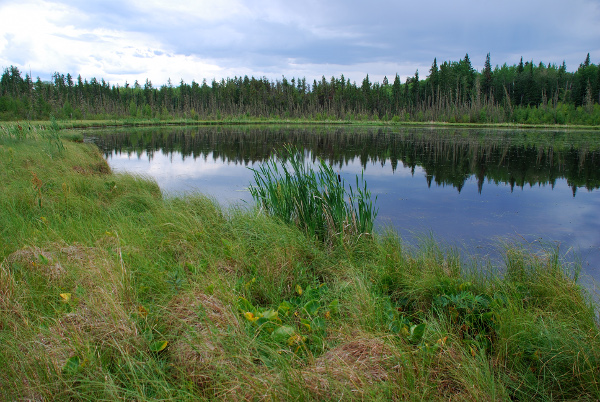Last week we learned the value of healthy soils and their role in flood mitigation . This week in honour of World Wetland Day 2014 on February 2, the Rewilding Our Rivers Discussion Series will turn its attention to the significance of wetlands and their potential role in flood mitigation.
Wetlands are often called planet earth’s kidneys because of their ability to purify our water supply through natural filtration systems that absorb heavy metals and other harmful containments (like phosphorus). Wetlands are complex ecologies that offer many benefits and functions to our shared bio systems – most notably, they are able to retain and store water. In essence, wetlands act like sponges; they absorb rainfall, slowly saturate soil systems, and eventually recharge aquifers. By retaining and storing water, wetlands reduce the speed and volume of water entering our streams and rivers. This can be particularly important for some flood events.
 |
| “Wetlands near Utikuma Lake, northern Alberta 2010” by Gord McKenna is licenced under CC BY 2.0. |
The Ramsar Convention defines wetlands as areas of marshes, bogs, fens and peatlands. They are ecosystems that contain plant and animal life in water saturated areas. A wetlands’ ability to retain and store water is greatly dependent on its soil system. For instance, peatlands have a significantly greater capacity to retain and store water because they are made up of rich organic matter developed over thousands of years. This highlights the symbiotic relationship between wetlands and healthy soil systems and the role they can play in flood mitigation. Peatlands have become important ecosystems to protect on a global scale due to the simple fact that they are nearly impossible to reconstruct. One example of this is located in our back yard. Alberta is home to a UNESCO World Heritage Site and a Ramsar Convention Wetland of international importance located in the Peace-Athabasca Delta in the Wood Buffalo National Park.
During all seasons wetlands play a role in water storage in Alberta. One study conducted east of Calgary determined that 274,000,000 square metres (m2) of currently established wetlands have the potential to store 36,000,000 cubic metres (m3) of water given a ratio of 0.131 m3 of water per m2 of a wetland[1]. In comparison, a recently constructed wetland by the City of Calgary designed to store a maximum of 7,000,000 m3 of water on 2,300,000 m2 area over a two month period had a ratio of 3.043 m3 of water per m2 of a wetland[2]. This demonstrates that constructed wetlands have the potential to play a role in flood mitigation, if they are properly designed. With this said, regeneration of an already functional ecosystem (current wetlands throughout Alberta) could play a larger role in water storage as they already have a base to build from.
Currently wetlands are being considered as one part of the solution for future flood mitigation in Alberta. The Bow River Flood Modelling project recently simulated a “what if” scenario to explore the role wetlands could play in a major flood event. This simulation used a scenario where the Bow Basin potentially detained ~24,000,000 m3 of water within ~118,000,000 m2 of wetlands. This “what if” scenario demonstrated the large area of wetlands required to detain large flood events resulting in valued discussion about the importance of wetlands in a healthy watershed and the functions they might perform in large versus smaller flood events.
Unfortunately, historically across Alberta and most of North America, many wetlands have been drained to support urban, agricultural and industrial development. The draining and destroying of wetlands over the past 100 years has lead to increased vulnerability in the face of changing climates and weather events.
Some research suggests that the most effective way to mitigate for floods is by restoring wetlands in the headwaters, followed by wetlands along the major rivers within the watershed[3]. There is no question as to the role wetlands can play in flood attenuation. By acting as ecological sponges they can delay peak flows by their ability to retain and store water. They offer a multitude of other benefits such as improving water quality, regulating our climate through carbon and nitrogen storage and contributing to increased biodiversity. However, they still remain highly vulnerable to urban, agricultural and energy development needs. How important are wetlands to the average Albertan? Do we feel as a society that these ecologies are worth protecting even if that means restrictions to resource development or urban growth?
Lauren Eden is a Researcher at Alberta WaterSMART
[1] Red Deer Water Shed Alliance. (2013). Background Technical Report on Riparian Areas, Wetlands, and Land Use
[2] Alberta Environment and Sustainable Resource Development. (2011). Ecosystem Services Approach Pilot on Wetlands: Integrated Assessment Report
[3] Hey & Phillipi. (1995). Flood Reduction Through Wetland Restoration: Upper Mississippi River Basin as a Case History. Restoration Ecology: The Journal of the Society for Ecological Restoration, 3(1).
